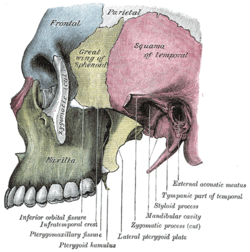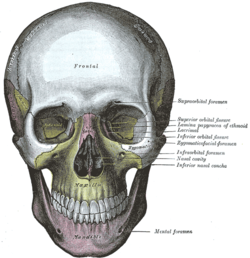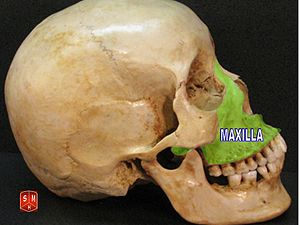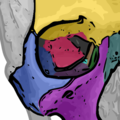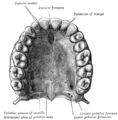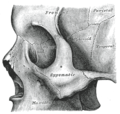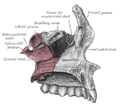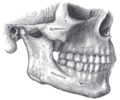- Maxilla
-
This article is about the human maxilla. For arthropod maxillae, see Maxilla (arthropod). For insect maxillae in particular, see Maxilla (Hexapoda).
Bone: Maxilla Side view. Maxilla visible at bottom left, in green. Front view. Maxilla visible at center, in yellow. Gray's subject #38 157 Precursor 1st branchial arch[1] MeSH Maxilla Dorlands
/ ElsevierMaxilla The maxilla (plural: maxillae) is a fusion of two bones along the palatal fissure that form the upper jaw. This is similar to the mandible (lower jaw), which is also a fusion of two halves at the mental symphysis. Sometimes (e.g. in bony fish), the maxilla is called "upper maxilla," with the mandible being the "lower maxilla." Conversely, in birds the upper jaw is often called "upper mandible."
Contents
Function
The alveolar process of the maxilla holds the upper teeth, and is referred to as the maxillary arch. The maxilla attaches laterally to the zygomatic bones (cheek bones).
The maxilla assists in forming the boundaries of three cavities:
The maxilla also enters into the formation of two fossae: the infratemporal and pterygopalatine, and two fissures, the inferior orbital and pterygomaxillary.
Components
Each half of the fused maxilla consists of:
- The body of the maxilla
- Four processes
- The zygomatic process
- The frontal process of maxilla
- The alveolar process
- The palatine process
- Infraorbital foramen
- The maxillary sinus
Articulations
The maxilla articulates with nine bones:
- two of the cranium: the frontal and ethmoid
- seven of the face: the nasal, zygomatic, lacrimal, inferior nasal concha, palatine, vomer, and the adjacent fused maxillary bone.
Sometimes it articulates with the orbital surface, and sometimes with the lateral pterygoid plate of the sphenoid.
In other animals
In most vertebrates, the foremost part of the upper jaw, to which the incisors are attached in mammals consists of a separate pair of bones, the premaxillae. These fuse with the maxilla proper to form the bone found in humans, and some other mammals. In bony fish, amphibians, and reptiles, both maxilla and premaxilla are relatively plate-like bones, forming only the sides of the upper jaw, and part of the face, with the premaxilla also forming the lower boundary of the nostrils. However, in mammals, the bones have curved inward, creating the palatine process and thereby also forming part of the roof of the mouth.[2]
Birds do not have a maxilla in the strict sense; the corresponding part of their beaks (mainly consisting of the premaxilla) is called "upper mandible."
Cartilaginous fish, such as sharks also lack a true maxilla. Their upper jaw is instead formed from a cartilagenous bar that is not homologous with the bone found in other vertebrates.[2]
Additional images
See also
- Bone terminology
- Terms for anatomical location
- Ossification of maxilla
- Hypostome
- Maxillofacial surgery
References
1.sicher oral anatomy 2. human anatomy by grey's 3.controversies in oral and maxillofacial surgery by peter warthington
External links
This article was originally based on an entry from a public domain edition of Gray's Anatomy. As such, some of the information contained within it may be outdated.
The Bones which form the Orbit Frontal bone • Zygomatic bone • Maxillary bone • Sphenoid bone • Ethmoid bone • Palatine bone • Lacrimal bone
Bones of head and neck: the facial skeleton of the skull (TA A02.1.08–15, GA 2.156–177) Maxilla SurfacesProcessesOtherZygomatic Palatine FossaePlatesProcessesMandible external surface (Symphysis menti, Lingual foramen, Mental protuberance, Mental foramen, Mandibular incisive canal) · internal surface (Mental spine, Mylohyoid line, Sublingual fovea, Submandibular fovea) · Alveolar part of mandibleMinor/
noseNasal bone: Internasal suture · Nasal foramina
Inferior nasal concha: Ethmoidal process · Maxillary process
Vomer: Vomer anterior · Synostosis vomerina · Vomer posterior (Wing)
Lacrimal: Posterior lacrimal crest · Lacrimal groove · Lacrimal hamulusCategories:- Bones of the head and neck
- Dental anatomy
Wikimedia Foundation. 2010.

